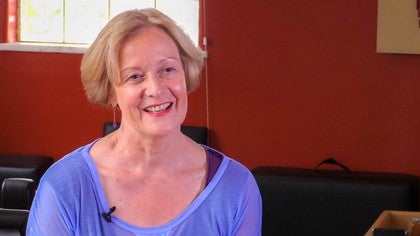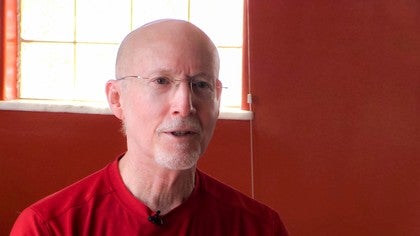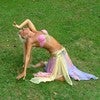Description
About This Video
Transcript
Read Full Transcript
My name is Celia Holton. I first met even 89. I moved from England to the States. Then I was a professional dancer in England. Um, and studied Pilatos for, or I started at the age of 16. I'm with Alan Herdman. So when I moved to the States and I was planning to go to [inaudible], a very long story, but I, I plan to go to massage school, but I really wanted to continue with Peloton.
So I looked up lot in Santa Fe and I saw E's there, Eve Gentry. So I made an appointment and came round to the studio and there was Michelle and there was Eve in her little garage. And um, I was struck by her cause she was so tiny and yet so forceful. She had a one wonderful character. She reminded me of my old dance teachers in England, mild modern dance teachers.
Very, very straightforward, quite strict, but also very caring. Um, and I don't remember too much of the lesson because about a quarter of the way into it, I think she passed me onto Michelle, but she got me on the floor and she's began to do feel good arm circles. You're going to lie on your side and you're going to move your arm over your head. And I was about 36 and I just stopped my professional dance career for about 15 years. I was a dancer and I started doing this circles and I thought, what am I doing this for? I, I, I, I didn't understand at all what, I'd never done them ever in my life before. And I was used, you used to working out very hard in Peloton. And I, I just thought, what is this?
And then we got past that and we were doing some other very small movements and I still didn't realize where she was at at all. And it was only till years later after I taught with Michelle how valuable these little small movements were. Um, and now they're one of the client's favorite exercise, which, and I pretty much always give them to my Polonius clients here. So that was my first impression of Eve. I'm not really understanding what she was doing in terms of her work, but then later on I'm really, really knowing what she was after. And I also have another example of that later on.
Um, when she taught her first, I think it was her first workshop in Santa Fe for, um, when we were starting to do a training program and people came from different parts of state and States, and I was involved in that workshop and I think it was that workshop she, she gave a demonstration of how she put pillows underneath people's bodies when they were lying down. So she was on the Cadillac putting pillows everywhere underneath person's shoulder, under an elbow, under a knee. And I remember distinctly remembering this right, this person's right shoulder his forward, why would she put a pillow under her right shoulder if it's forward. It's just going to make it go further forward. I mean, this was our thinking in my head, but I may, I was very respectful. I thought it must be something to this. And of course, years later down the line, when I had my own experience as a teacher, I realized exactly why, but that proprioceptive sense of having a pillow under there allows the client to drop into the pillow and open up that area that's may be pulled forward, forward for pain or whatever reason.
But I remember from that workshop it was mostly for people in pain and she felt it was that they needed to feel totally comfortable lying down, that there shouldn't be any place in their body where there was a little build up of tension. And so I've always remembered that in my whole life. And although I don't put a lot of pillows onto people, I'm always aware of looking at them and seeing their stress points and knowing how to help them in that. From, from that little workshop we did, it was, it was wonderful. I remember I'm not, I'm on a video doing a full roll up and I remember being a little nervous modal outfit without teaching me in the early days when I first moved here, it was 20 years, 22 years ago. Um, British politesse had, there was just um, well or a few teachers in England and not as many as there are now. And Pella is, or just been, teachers had gone over to like Alan had gone over to America and learnt piles and come back and just taught it. A few of those exercises, not all of them. So the ones I learned I think were half of what I learned when I came to the States. I learnt the whole pallet is a reformer repertoire, which I never learned in Britain. I learned just a few.
And I think partly the reason for that was that in Britain the rooms were so small that you can't have five reformers or 10 reformers in a room. You have, you go on a circuit. So you just do five or six exercises on the reformer and five exercises on the mat or five. So you never, you never really learnt a whole bunch of things that you could choose from. You had a little sort of your own little plan and they would give you an extra left exercise here and there. And maybe that's the reason why everything was the, the exercises and each piece of equipment or cat's so small. Um, because I just couldn't believe it when I moved here.
I couldn't believe all the Cadillac exercise that I'd never done, never seen the reformer exercising. So it was, I was astonished and I was nervous that I had to learn all of these things and then know how to teach them too. But now everyone, it's a, as I said, it's a global community and everybody knows everything cause I can see it all them on video. I, I see Eve Eve's legacy, uh, um, as so important to me and to everyone because she introduced to me and a lot of other people, the fundamentals, which taught me how to warm up a client. I mean, by then I'd come through my dance career. So warming up wasn't such an issue, but if I'd known some of those techniques earlier, I'm sure I would have used them. I just would have my own agenda for a Walmart beauty as a dancer. But the coccsyx calls the, the feel good arm circles, the puppet arms breathing.
I never really thought about that. Even, even when I was doing my own Polarez workouts in England. I mean it was talked about but never really lying on the floor. And just starting with that kind of relaxation approach. Um, I, it, I was always working on stabilizing right away. Um, as a, as when I'd used to take my lessons, I'll do them myself.
So I always start off with this stuff. Almost always she wasn't dogmatic. I mean she was strict about what she saw and what she taught and with the person in front of her, but just the fact that she put masses of pillows under people and did a lot of mobility. Joint mobility showed me that she had to be open to other modality, had to have started felon and Christ Alexander work worked with her own body as well. Um, and I think if she was alive today, she would probably have moved on into other arenas with her. With Peloton is too. Um, no, I never felt she was hugely strict in, in us teaching what, what, what she taught that we had to teach the way she taught.
I never got that from her at all. The foot that I just have one besides the propping up of the pillows. I just have one strong memory of her walking into the studio. Um, and if this was a number 28, this is after she'd moved out of her garage and Michelle had started a training program and Eve was coming in sort of supervising things and I was sitting like, I'm sitting now, still do it. She came in and just stared at my foot and I kind of looked at her, cause she always had that very strong kind of energy and unforced just in her presence. There's a little tiny person. I said, do you know that your right foot is towed in and your other foot isn't?
And I looked down and I said, Oh yes, I need to straighten it out. Just sat through attention and that was it. She just sort of moved on. What I take away from that is her observation and um, of course I've been trained beautifully by Michelle to observe a client and see where they're moving and not moving and what's not straight. But that, that really struck me. And so I'm always looking for those in autos out on one foot. There's not straight like the other. I was a little afraid of her, I have to say, I wish I could have got to work with her a little bit more.
But I think she felt when I S when I took that first lesson and subsequent lessons in the old studio, her old garage, I think she felt she needed that I needed more of a harder, faster workout. And that's what I was used to. And so she would put me with Michelle, but it was only later on when Michelle opened the studio and he was, had stopped teaching in her garage and was not teaching very much. I think it's all, she was just coming to the studio and monitoring the studio that, um, I really, I really could see the difference between the two. I mean she, she, she was just a force to be reckoned. I was always very, um, what's the word? Very um, respectful of her when Eve came to the Institute and she was starting to have many strokes. Um, she requested lessons from us. I think. I, I don't think I taught him more than one or two. I think it was more Wayne that tutor cause I think he was just better for her at that time. Maybe cause he was a man, but she was starting to shuffle a lot, but she was still, she would still walk out very powerfully. Um, but that got slowly worse over the year that she was coming in.
And I remember again, these images I have of her are very strong for a little, little tiny things. But I said, Eve, let's go outside. And she said, I've got to walk properly. I've got to walk normally. Cause she was shuffling at this point and she couldn't stop herself from shuffling. So I held onto her arm and I took steps with her and I said, take a step with me, step with your right leg and now step with your left and take a bigger step, not just to one footstep. And, and we, we managed to do that going down the, the little sidewalk next to the studio and then she would revert back into the shuffle. And I remember her really wanting to change that, but I don't think I could. I think neurologically everything, things are changed and, and that got slowly worse and she got more and more rounded over two as well. I was, it was, it was sad to watch, uh, uh, go downhill like that after being such a vibrant woman. I'm not, I'm not sure if she was aware. I think the, when I was working with her, I think she was aware of what was going on, but I don't know later down the line, I'm not sure if she was, when she stopped coming to the studio.
I think she was starting to go in her mind too. I have another memory of Eve. Um, and I used to tell the students, there's one, we were training students for core dynamics when, um, in 89 when I came in, in her old studio, I remember walking in and there she was doing 32 teasers off the bat really fast. And I could, I, she just, she just walked in, got down on the floor and did it. It was just astonished, cause I don't think I could have done that. That she, what was she then 70 something and I was 36, 80 years old and Teza one off the other fast little butterfly. She was.
Pilates Legacy Project: Discussions
Comments
PS: BTW, I may start saying it as you have if you don't mind!

Spanish is my natural language.
Connie Cordova
You need to be a subscriber to post a comment.
Please Log In or Create an Account to start your free trial.
















